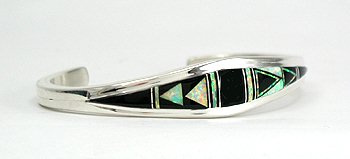Hi Paula,
I think the opals used on bracelets are mostly (very pretty) Gilson opals. Am I right? I have a Thomas Francisco designed bracelet, and although nothing says synthetic, I think they must be, they really look like the Gilson opal pictures.
Susan
Hi Susan,
Great question and a good topic. First of all, we’ve never seen Native American pieces that use natural or precious opal. As you will read below, part of the reason is the scarcity and availability of precious opal.
But the other factor is that when used in inlays or other settings, natural opal has a higher tendency to crack than lab or imitation opal. So when we purchase items with opal in them and ask the artists about the materials, about the opal, they reply “lab opal” but most opal used in Native American jewelry is actually imitation opal.
Opal
Opal has a latticework of spheres and spaces that play with light as it passes through – something like a prism.
Light passes through the arrangement, speeding up and slowing down as the size of the spheres and spaces between them changes and as the the angle of view changes.
The longer light waves produce RED-PINK color hues.

Imitation Pink Opal
The shorter waves produce the BLUE-GREEN color hues.

Imitation Blue Opal Bracelet by Thomas Francisco, Navajo
So when you wear your opal jewelry indoors under various types of lights and outdoors under different light settings, you will see a change in the stones. Photographing opal to show its great variety is indeed a challenge !
Natural opal (also known as precious opal) contains between 3-10% water but can be as high as 20%
For technical information about natural opal.
Lab opal is considered a true synthetic or created opal – produced in controlled laboratory conditions and with the same chemical composition as natural opal but with a very low moisture content.

Zuni Imitation Opal Butterfly Pin Pendant by Earline Edaackie
Some lab opals are more expensive to produce than the natural stone would cost. Lab opal is very resistant to breaking due to the fact it does not contain as much water as natural opal.

Multi-Color Imitation Opal Corn Row Watch by Thomas Francisco, Navajo
Gilson opal is the premier lab opal, the choice of many Native American artists.
Gilson opal production began in 1974 by Pierre Gilson when he discovered the ordered sphere structure that gives precious opal its light reflecting abilities. Laboratory production of opal is a highly complex process that can take over a year to complete. The colors are natural without color enhancement.
Imitation opal AKA artificial or simulated opal is different chemically from natural or lab opal. It is made up of 80% silica and 20% resin and is an economical option to both precious and lab opal.
Even when opal is not used as the main stone, but as an accent such as in this link bracelet, it brings a whole new dazzle to the piece.

Rhodochrosite, Imitation Opal and Mother of Pearl Inlay Braclet by Shirley Tso, Navajo



